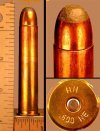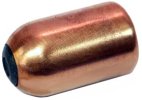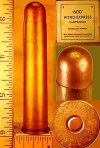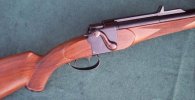monish
AH elite
.600 Nitro Express
The .600 Nitro Express is a round in the Nitro Express series which was introduced in 1903. It is the second largest calibre in the Nitro Express line, exceeded only by Holland & Holland's .700 Nitro Express round.
It was developed for elephant guns, but most hunters felt that it was too powerful and harsh in recoil for anything but emergency use to stop a charging animal. Because of the larger cartridge, there was more recoil and guns chambered to fire the .600 were significantly heavier than those firing the .577 Nitro Express, which was already considered as being at the extreme end of manageable gun size and weight for a professional hunter.
English professional hunters using .600 Nitro double rifles generally had them carried by a gun bearer until just before they were needed. This was because these rifles often weighed 15 pounds (6.8 kg) or so, and an exhausted carrier simply could not use one effectively in an emergency. Slightly smaller-calibre rifles were used for all other shooting.
Classic 20th-century .600 Nitro double rifles were almost always completely hand-made from raw steel and the best walnut wood, and they were and are extremely expensive. Making one could employ a gunsmith working full-time on a single rifle for many months, even for a whole year. Like other double rifles they were regulated so that both barrels would shoot to the same point of impact at the range specified by the customer. For a high-grade specimen in good condition, a price in excess of $100,000 can be expected.
All .600 Nitro Express cartridges carried a 900 grain projectile. Early versions were loaded with cordite. While the .700 Nitro is of course larger, the .600 Nitro is the largest dangerous game caliber to have been used during the heyday of African ivory hunting. The .700 was a 1980s creation as a result of a well-to-do gentleman being denied a 600 NE calibered rifle from renowned maker Holland and Holland.
Though the .600 was larger than the .577, it was not nearly as popular among professional hunters of the day. In use, a professional hunter would carry this rifle only when expecting a charge, or when the hunter was in the "thick brush", with a gun-bearer carrying it at other times. The rifles chambered for these rounds were most often side-by-side double rifles with boxlock actions made by the Jeffery Company of England. However, Jeffery did introduce their Model 1904 Farquharson-based falling block, single shot rifle in 1904 specifically for the 600 NE.
.600 Nitro Express
• Type Rifle: Hunting
• Place of origin: UK
• Production history: Designer Jeffery
• Designed 1899
• Produced 1903
Specifications
• Case type: Rimmed
• Bullet diameter: .600 in (15.24 mm)
• Case length: 3 in (76 mm)
• Filling: Cordite
• Filling weight: 120 grains
Ballistic performance
Bullet weight/type - Velocity - Energy
• 900 gr (58 g) SP/FMJ - 2,050 ft/s (620 m/s) - 8,400 ft•lbf (11,400 J)
Monish
The .600 Nitro Express is a round in the Nitro Express series which was introduced in 1903. It is the second largest calibre in the Nitro Express line, exceeded only by Holland & Holland's .700 Nitro Express round.
It was developed for elephant guns, but most hunters felt that it was too powerful and harsh in recoil for anything but emergency use to stop a charging animal. Because of the larger cartridge, there was more recoil and guns chambered to fire the .600 were significantly heavier than those firing the .577 Nitro Express, which was already considered as being at the extreme end of manageable gun size and weight for a professional hunter.
English professional hunters using .600 Nitro double rifles generally had them carried by a gun bearer until just before they were needed. This was because these rifles often weighed 15 pounds (6.8 kg) or so, and an exhausted carrier simply could not use one effectively in an emergency. Slightly smaller-calibre rifles were used for all other shooting.
Classic 20th-century .600 Nitro double rifles were almost always completely hand-made from raw steel and the best walnut wood, and they were and are extremely expensive. Making one could employ a gunsmith working full-time on a single rifle for many months, even for a whole year. Like other double rifles they were regulated so that both barrels would shoot to the same point of impact at the range specified by the customer. For a high-grade specimen in good condition, a price in excess of $100,000 can be expected.
All .600 Nitro Express cartridges carried a 900 grain projectile. Early versions were loaded with cordite. While the .700 Nitro is of course larger, the .600 Nitro is the largest dangerous game caliber to have been used during the heyday of African ivory hunting. The .700 was a 1980s creation as a result of a well-to-do gentleman being denied a 600 NE calibered rifle from renowned maker Holland and Holland.
Though the .600 was larger than the .577, it was not nearly as popular among professional hunters of the day. In use, a professional hunter would carry this rifle only when expecting a charge, or when the hunter was in the "thick brush", with a gun-bearer carrying it at other times. The rifles chambered for these rounds were most often side-by-side double rifles with boxlock actions made by the Jeffery Company of England. However, Jeffery did introduce their Model 1904 Farquharson-based falling block, single shot rifle in 1904 specifically for the 600 NE.
.600 Nitro Express
• Type Rifle: Hunting
• Place of origin: UK
• Production history: Designer Jeffery
• Designed 1899
• Produced 1903
Specifications
• Case type: Rimmed
• Bullet diameter: .600 in (15.24 mm)
• Case length: 3 in (76 mm)
• Filling: Cordite
• Filling weight: 120 grains
Ballistic performance
Bullet weight/type - Velocity - Energy
• 900 gr (58 g) SP/FMJ - 2,050 ft/s (620 m/s) - 8,400 ft•lbf (11,400 J)
Monish






